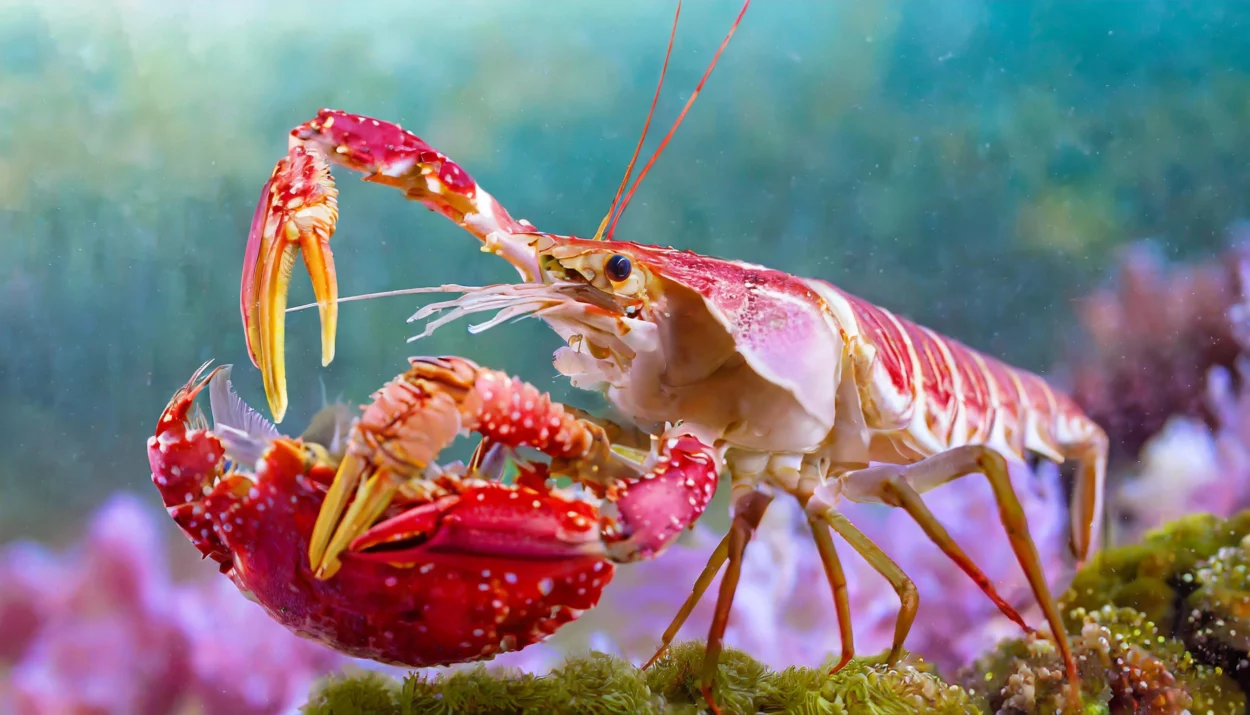This article is dedicated to my friend and partner Sarah.
When I think of shrimps, the first thing that comes to mind is how many of them I ate in my previous life. It's really nasty when I literally feel sick just thinking about it today.
Yet these creatures are so cool. Let's take a look at the mantis shrimp. There is hardly a colour in which there is not a species of it, there are even some in pink. And yet they are predators that slay their prey with the force of a pistol bullet or impale it with deadly sharp claws. Their armour is a marvel of material science. It absorbs the recoil of a 22-calibre revolver and deflects it. Otherwise the animal would burst. There have been attempts to utilise this technology in tanks and other technical equipment. To my knowledge, without success.
It's a completely different story with each other. Many Mantis shrimps move into a cave with their partner, look after their offspring together and - hold on tight - stay together for life. This is usually around five years. But it can also be up to twenty years. They have a few things over me. They spend most of their time in their cave and other hiding places. Despite their immense striking power, which allows them to generate lightning bolts of over 4,000 degrees underwater, they lead a hidden life.
Another special feature that makes her unique is her eyes. They are mega freaky. I had a closer look at them a long time ago. And I didn't quite understand some things. My consolation, the authors probably didn't either. The eyes of the Mantis shrimp are located far above the body on rod-like extensions. They can be moved independently of each other and can also be focussed individually at completely different distances. According to the current state of knowledge, the information is transmitted directly and simultaneously to the brain, where it does not have to be processed, assembled into a whole and interpreted as it does in humans. The Mantis shrimp can therefore focus on the book in its hand and the television picture at the same time. However, television is too boring for it, because with its 12-16 different colour photoreceptors - three times as many as in humans - it can see more information than today's cameras can capture. Several universities and tech companies are currently conducting research into this. Once again, I'm trying to make a very shaky scientific comparison, but it illustrates how blatant this is and why so much money is being invested in researching this technology.
Imagine you are in a 3D cinema for the first time in your life. The effect created by the glasses is based on polarised light. And now you put on a second and third pair of glasses with a technology that has not yet been invented. Now you see the world with different eyes. You can read DVDs, but you are technologically superior to standard DVD players and every other living being known to us. You can suddenly recognise cancer cells on the human body even before they become tumours. Healthy cells reflect circularly polarised light differently. And that's not all. We still know so little. Because we cannot see it with our eyes and have not yet developed a camera that can visualise what is hidden from us, it is difficult to say what we do not see. What we do know is that mantis shrimps can see the activity of neurones with the naked eye. That is intense. If you had a camera that could do that...
Everything about these cute little animals is simply fascinating. Mantis shrimps don't really eat a vegan diet. There are basically two species. One spears its prey, the other kills it with a crushing pressure wave. Some species grow to a size of 45 cm. Their diet is correspondingly varied. Fish, crabs, mussels, snails, worms, shrimps and squid. Like all animal species, they do not belong in the aquarium. If they recognise their own reflection in the glass, they fight it and sometimes punch holes and cracks in the glass, unless armoured glass has been used. Which is also available to buy for aquariums specifically for this reason. Without question, this is cruelty to animals, but everything that comes from the sea is not subject to the Animal Welfare Act. Well, theoretically it is, but the individual paragraphs only refer to vertebrates and well, crustaceans have a shell, not a spine, so they are not vertebrates. The legislators really believe that marine animals have no feelings or whatever. Has anyone ever considered taking legal action against this?
Quite apart from the fact that the applicability of our Animal Welfare Act is a bad joke anyway. Section 2 sentence 1 TSG in the updated version of 2022 states unequivocally that anyone who keeps, cares for or has to care for an animal must provide the animal with appropriate nutrition, care and accommodation in accordance with its species and needs. This excludes all non-domesticated animals from being kept as pets. Wild animals belong in the wild and not in a cage or aquarium.
Admittedly, the mantis shrimp has nothing to do with a shrimp. But neither does it have anything to do with the mantis shrimp. It belongs to the stomatopod family and there are... gap in my knowledge, I think 450 different species. Mantis shrimps are 170 million years older than the dinosaurs and although humans are their biggest enemy, along with tuna fish, they are currently considered endangered. Oh yes, even though they are not shrimps, we still eat them. In Mediterranean cuisine, for example.
And because today is Monday, well, and because I think the hunting method is so blatant, here's a video today. An aquarium video at that. I love aquariums so much. But you rarely see this in the wild when a high-speed camera is at the start. Sir David Attenborough might have something up his sleeve, but I'm probably not allowed to show it for copyright reasons.
Source: https://youtu.be/tdXDAPXDiYQ
)
And because I'm still planning to save the world, here's the matching greetings card from my merch shop. If you want to protect the oceans in the long term, you can become an ocean sponsor. I have one for 180,- € per year via the NABU completed.

https://shop.paddys.de/product/greetings-card-kubistic-mantis-shrimp-square-portrait-125cm-x-125cm/
Greetings Card Mantis Shrimp
€5
Mantis shrimps may be small, beautiful and boast vibrant colours, but they are also deadly and are able to club prey with the force of a bullet or spike them with lethally sharp claws. There are around an incredible 450 species of mantis shrimp worldwide, and their colours range from shades of brown to bright, green, red and blue. Stomatopods began evolving independently from other members of the class Malacostraca nearly 400 million years ago, about 170 million years before dinosaurs. (Murex Dive Resorts)
Artist: Paddy | insta @paddylicious
⚖ 340gsm high quality 🤍 white woodfree uncoated 🍁 natural offset paper 🍓 produced using pulp in white 🍃 organic 🌱 vegan 🌳 saves 1 sqm rainforest 💨 produced with renewable energy 💧 sewage drinking quality 🌿 plant-based packaging 💚 made for you with love ❌ cruelty-free ❌ not tested on animals ♻ renewable 💲 non-profit







